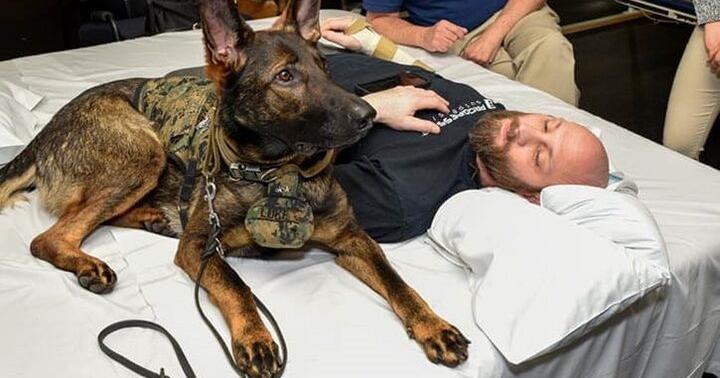

FALLS CHURCH, Virginia — The Defense Department’s first facility dog program began back in 2005, when then-Army Sgt. Harvey Naranjo saw the positive impact that man’s best friend can have on troubled Soldiers.
Naranjo was working with injured special forces warfighters in a therapeutic horse riding program. He was struck by how the wounded warriors interacted with the stable dogs.
“These tough guys, who have gone through traumatic injuries, amputations, and had been shot-all of a sudden, I see them rolling around on the floor, baby talking to the dogs, and I saw them put their guard down,” Naranjo said.
He could see a “true personality emerge from the very reserved service members for the first time.”
“I thought of how much more I could do for them if I had a dog,” said Naranjo, who now runs the adaptive sports program for the Occupational Therapy Department at Walter Reed National Military Medical Center in Bethesda, Maryland.
At the time, Naranjo mentioned this observation to a hospital volunteer, who soon sent him a chocolate lab named Deuce.
“And before I knew it, there was a dog in the clinic,” Naranjo said.
Since then, the facility dog program at Walter Reed has grown and the concept has spread to other military medical treatment facilities.
Facility dogs can help patients with stress, depression and anxiety. They provide distraction, unconditional love and comfort, helping patients to recover or better cope with health problems. And they help to decompress staffs and patient families.
There are currently seven facility dogs at Walter Reed. All are highly trained by outside organizations and include golden retrievers, Labradors and one German Shepherd.
Handlers say that for every hour the dogs work, they have a positive impact on 12 patients and their families. On average, these dogs work over 200 hours per month, collectively, and have contact with 2,500 people.
Before COVID-19, five to seven inpatients specifically requested a facility dog (therapy support dog) visit every day. Currently, the dogs are supporting staff, patients and families in outpatient settings. (Handlers ensure the individual dogs’ workdays are limited and that each canine gets plenty of rest.)
The dogs often fill an important role in the care of injured or ill service members or other patients who may have a long path of recovery.
“Our service members are missing their homes, and they’re missing their families and their pets. This is like an extension of their pets,” Naranjo said.
Walter Reed’s Dog Program
Today, the Facility Dog Program at the medical center includes Sully, a yellow lab who was former President George H.W. Bush’s service dog.
Each dog has his or her own rank, service and uniform and is inducted in an enlistment or commissioning ceremony.
Each dog initially undergoes traditional service dog training with an accredited outside organization, which prepares them to be paired with a disabled service member or veteran to provide assistance with tasks and companionship. After that, the dogs at Walter Reed undergo additional training to become a “facility dog” that will work in a clinical setting like a hospital.
Amy O’Connor and Patty Barry oversee the facility dog program video of the Walter Reed Bethesda Facility Dog Program on the dvidshub.net website, and Naranjo is the program service dog patient education and referral liaison.
“I’ve had the privilege to be part of this program for over 15 years and have a wonderful group of handlers that are primarily active duty service members who do the handling of the dogs as a collateral duty. This program is truly nobody’s job; we all give a little bit of ourselves to make it work,” O’Connor said
“We try to switch them up in their daily duties,” said Navy Hospital Corpsman Skylor Cervantes, the lead handler. “Different dogs can go to different areas, and different people can meet the different dogs, have different interactions with them because they all have their own unique personalities. Some of the dogs do work in specific locations, but they also get to visit other locations.”
One area the dogs visit every day is the Military Advanced Treatment Center, where wounded warriors rehabilitate, O’Connor explained.
Truman, a chocolate lab with the rank of Army master sergeant, is the resident MATC dog, Naranjo said.
Additionally, the dogs work as part of community reintegration, Naranjo said, adding that some service members may develop anxiety about traveling after losing a limb.
“Having the dog with them plays a huge role in deflecting some of the stares that they may get from people or just their anxiety in general from accessing community again in a new body,” Naranjo explained.
How Are Therapy Dogs Trained?
All the center’s dogs are “purpose-bred and -trained to be service dogs for our wounded warriors. And in that process, they are trained for 18 to 24 months,” O’Connor said.
“We don’t stop learning and working to get better,” she said.
Each Walter Reed therapy dog handler goes through a training program, the personnel qualification standard, to ensure confidence, consistency and solid handling skills. It generally takes about six weeks of training with two-to-three hours a week of practice.
At the end of the day, all facility dogs go home with their owner-handler, so it’s a full-time commitment.